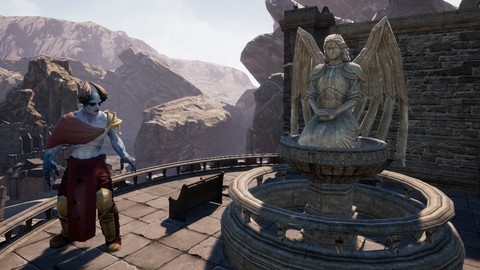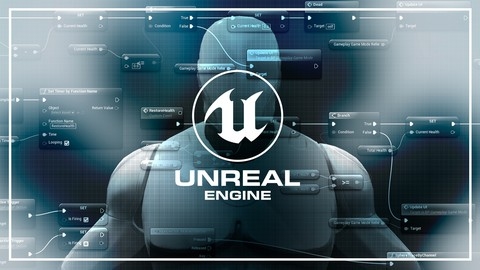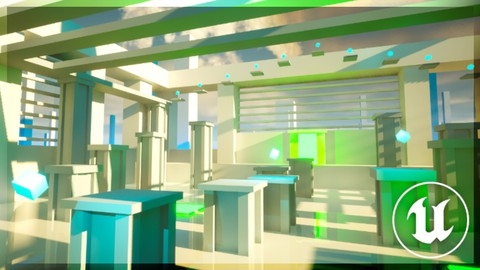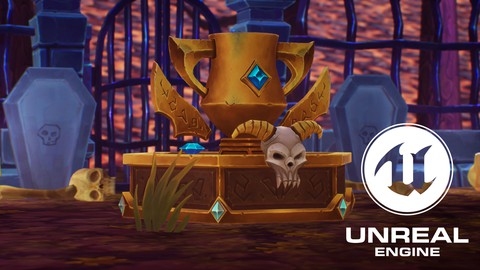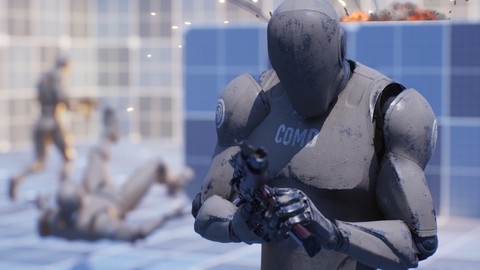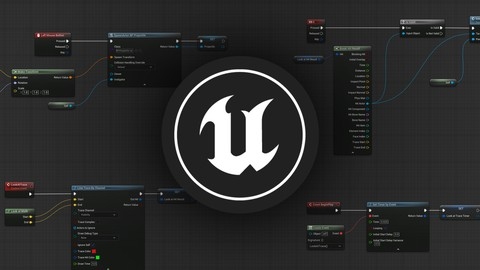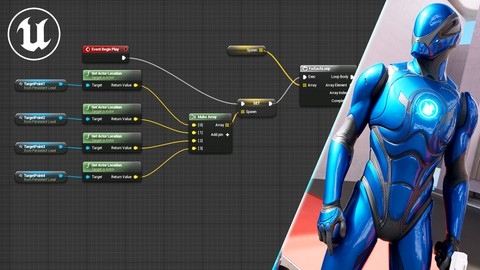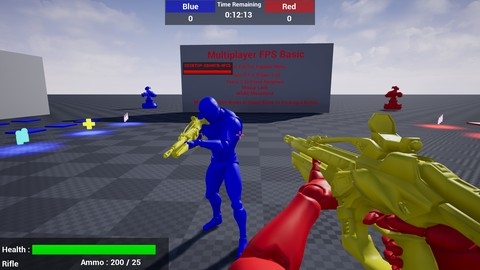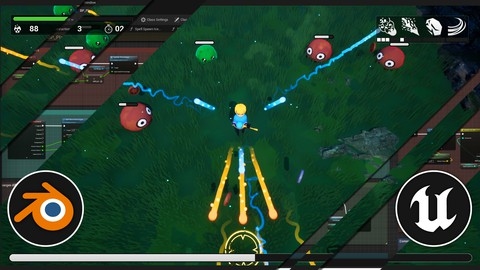Unreal Engine is a powerful game development platform, and Blueprints is its visual scripting system, allowing you to create complex game mechanics without writing code.
Learning Blueprints opens doors to a world of game development possibilities, enabling you to bring your creative visions to life.
You can build immersive worlds, design engaging gameplay, and craft interactive experiences that captivate players.
Finding the right Unreal Engine Blueprints course on Udemy can be daunting, with so many options available.
You want a course that’s comprehensive, engaging, and taught by experts, but also fits your learning style and goals.
You’re looking for a program that goes beyond the basics, providing practical experience and hands-on projects to solidify your understanding.
For the best Unreal Engine Blueprints course overall on Udemy, we recommend Unreal Engine 4 Class: Blueprints.
This comprehensive course covers a wide range of topics, from fundamental concepts to advanced techniques, taking you from beginner to proficient Blueprint user.
You’ll learn about variables, data types, flow control, events, functions, arrays, enums, and more.
The course also includes a complete game project, “The Grid,” which provides practical experience in applying your knowledge to create a fully functional game.
This is just one of the many exceptional Unreal Engine Blueprints courses available on Udemy.
Keep reading to discover more options tailored to different learning styles and goals, including courses focusing on specific game genres, advanced techniques, and Unreal Engine 5.
Unreal Engine 4 Class: Blueprints
You’ll learn what Blueprints are, their structure, execution order, and how to use comments and reroute nodes.
The course dives deep into variables, covering different data types like integers, floats, booleans, vectors, rotators, strings, and more.
You’ll learn how to perform operations on strings and use math operators.
It also teaches you about conditionals, getting and setting variable values, and the difference between public and private variables.
Arrays are a crucial topic, and you’ll understand what they are, how to create them, and perform various operations like getting items, finding items, inserting, removing, and clearing arrays.
The course even includes exercises to practice arrays.
Flow control is essential in programming, and the course covers branches, sequences, loops (for, while, do N, do once), flip-flops, gates, and multi-gates, with exercises to reinforce your learning.
Events, functions, and macros are explored in-depth, including their use cases, collapsing nodes, custom events, inputs, and outputs.
You’ll also learn about creating and using macros and accessing the macro library.
The course introduces you to enums, covering how to create them, get and set their values, compare values, and use switch statements on enums.
It then dives into the essential classes in Unreal Engine, such as Actors, Components, GameMode, Pawn, Character, and Controller.
You’ll learn about static and skeletal meshes, transformations, spawning and destroying actors, triggers, and more.
Communication between Blueprints is crucial, and the course covers direct communication, casting, Blueprint interfaces (theory and implementation, inputs, and outputs), and event dispatchers.
The course provides a comprehensive understanding of creating first-person and third-person characters, covering aspects like camera control, player input, movement, jumping, crouching, sprinting, interacting with objects, grabbing and throwing objects, and animations.
Time and space control are essential topics, covering timelines (float, vector, event, color tracks, curves, loops, lengths, playback positions), timers, delta time, FPS, tick events for movement, vector operations (direction, length, normalization, rotations), and velocity.
You’ll learn about the PBR workflow, creating and working with materials, using textures, UVs, emissive colors, normal maps, ambient occlusion, lerping, and scalar, vector, and texture parameters.
The course also shows you how to create and use material instances with Blueprints.
User interface is an integral part of game development, and the course covers Widget Blueprints, layout panels, adding and removing widgets, input modes, mouse cursors, setting focus, buttons, text (including custom fonts and dynamic text), and creating a pause menu.
The course includes a comprehensive project called “The Grid,” where you’ll create a complete game from start to finish, covering all aspects like game design, level layout, player mechanics, enemies, scenes, materials, HUD, menus, keys, totems, paths, portals, colors, post-processing, bosses, bugs, audio, and more.
Unreal Engine 4 Blueprints - The Ultimate Developer Course
The course covers an extensive range of topics, taking you on a journey from the very basics of Unreal Engine to creating complete games.
You’ll start by learning how to download and navigate the Unreal Engine editor, understanding the viewport and its icons.
This course will teach you about actors, components, and the engine’s hierarchy, giving you a solid foundation.
As you progress, you’ll dive into blueprints, learning about events like BeginPlay, Tick, and overlap events.
You’ll also learn how to use nodes like Sequence, IsValid, Impulse, and Equals Object.
The course covers important concepts like casting, particle emitters, scene components, and more.
One of the highlights is learning level design, where you’ll create your first game.
You’ll work with pawns, movement, trigger volumes, jumping, pickups, and assets like physical materials and sound assets.
The course even teaches you how to implement features like saving games, HUDs, buttons, doors, and movement inputs.
But that’s not all – you’ll also learn advanced techniques like creating explosions, animating widgets, binding text, using interfaces, construction scripts, dynamic materials, procedural fences, collision volumes, progress bars, and event dispatchers.
There’s even a challenge to implement health pickups.
You’ll create two more games, including a mobile game.
You’ll learn about game states, countdowns, game over screens, level completion, and game instances.
For the mobile game, you’ll work with top-down projects, room blueprints, character animation and movement, touch input, cameras, cursor icons and animations, character selection, camera dragging, switches, doors, puzzles, and even vertex fogging and post-process volumes.
Throughout the course, you’ll learn how to package your games for release.
Unreal Engine 5 Blueprints: First Person Shooter (FPS)
The course starts by guiding you through the setup process, including downloading necessary assets and getting familiar with the Unreal Editor.
You’ll learn essential skills like placing actors, working with object hierarchy, and understanding character movement mechanics.
Once you have a solid foundation, you’ll dive into creating the main elements of the game.
This includes building the character with animations, implementing weapons with features like aiming, muzzle flashes, and firing sounds.
You’ll also create an enemy drone that can chase the player, explode on contact, and patrol predefined points.
The combat system is a crucial part of any shooter game, and this course covers it in depth.
You’ll learn how to implement crosshairs, damage systems, character health bars, automatic firing, ammo mechanics, and pickups for health and ammo.
The course even touches on cool details like changing the drone’s lights based on its aggro state.
But it’s not just about the gameplay elements.
You’ll also learn how to create a complete game mode with different session states like warmup, in-progress, player won, and player died.
You’ll work with time formatting and keep track of the remaining drones.
Throughout the course, you’ll utilize powerful Unreal Engine features like Animation Blueprints, state machines, line traces, overlap events, and Blueprint functions.
The instructor also covers important concepts like input handling, organizing assets, and leveraging the object hierarchy.
Unreal Engine 5 Beginner Blueprints: Make your first game!
The course takes you through the entire process of creating a complete game using Blueprints in Unreal Engine 5.
You’ll start by learning the basics of downloading and navigating Unreal Engine 5, setting up your project, and importing assets.
Then, you’ll dive into creating your player character, complete with mechanics like sprinting, head bobbing, and sound effects.
The course covers essential game elements like moving platforms, pressure plates that trigger sounds and animations, deadly spikes as obstacles, and a fade in/out widget for the death screen.
You’ll also learn how to implement collectible gems, an exit door system, and a subtitles system for accessibility.
A significant portion of the course is dedicated to level design, where you’ll design and build four distinct levels, incorporating the various elements you’ve learned.
The course guides you through lighting and prepping a template level, then constructing each level and linking them together.
Once you’ve built your game levels, you’ll create menus like the main menu, level selection screen, and pause menu.
The course also covers polishing touches like improving the character blueprint, adding reliable play area boundaries, and incorporating a looping soundtrack.
Throughout the course, you’ll work extensively with Blueprints, learning how to create and modify them for various game mechanics and systems.
The hands-on approach ensures you gain practical experience in Unreal Engine 5 and Blueprints.
Unreal Engine 5 (UE5): Blueprints for Beginners
You’ll start with the fundamentals, learning about variables, branches, events, functions, and macros.
From there, you’ll dive into more advanced topics like arrays, execution flow control with constructs like for loops and while loops, and enumerations.
The course also teaches you about Blueprint classes like actors, pawns, characters, and player controllers, which are essential for building games.
You’ll learn how to create Blueprint actors, spawn and destroy them, work with scene components, and handle overlap events.
The course even covers Blueprint communication techniques like casting, Blueprint interfaces, and event dispatchers.
But it’s not just theory – you’ll also build a complete game from scratch.
You’ll create the game mode, player controller, character movement, lootable objects, platforms, level transitions, and rewards.
Along the way, you’ll apply everything you’ve learned about Blueprints to bring your game to life.
The course includes access to a community Discord server for support and a downloadable project file for the game you’ll build.
Unreal Engine 5 Blueprints: Develop Your First Two Games
You will start by learning the basics of Unreal Engine, including how to navigate the interface, import assets, and create levels.
The first game you’ll build is Speed Ball, a simple yet engaging game where you’ll learn how to create a ball that can move and collect stars.
You’ll dive into Blueprints, learning about variables, classes, and communication between Blueprints.
You’ll also create checkpoints, a portal, and a winning condition, complete with a win screen UI.
The second game, Clone Strike, is a more complex first-person shooter.
You’ll set up a character with movement and animations, create enemies with AI that can chase and attack the player, and implement features like weapon firing, reloading, and damage systems.
You’ll also design UI elements like the main menu, in-game UI, and game over screen.
Throughout the course, you’ll learn essential Unreal Engine concepts such as lighting, post-processing, and packaging your game for distribution.
You’ll also explore advanced Blueprint topics like interfaces, casting, and animation Blueprints.
One of the standout features of this course is the emphasis on creating complete, polished games.
You won’t just learn individual concepts; you’ll see how they all come together to create a cohesive and engaging gaming experience.
The course also provides access to a community Discord server, where you can get support and connect with other learners.
Unreal Engine 5 : Getting Started with Blueprints
You’ll start with an introduction to Blueprints, covering the basics of event flow and variables.
From there, you’ll dive into the core concepts like functions, macros, structs, enums, events, and inheritance.
The course doesn’t just stop at the fundamentals.
It explores advanced topics like casting, event dispatchers, interfaces, components, and game modes.
You’ll also learn about utility nodes and the game instance, giving you a well-rounded understanding of Blueprints.
The course delves into additional lessons that will take your skills to the next level.
You’ll learn about traces, data tables, overlap nodes, input events, enhanced inputs, tags, spawning actors, code organization, debug tools, timelines, sockets, movement components, and even audio and particle effects.
Widgets are also covered in-depth, including layouts, creating widgets, binding, borders, overlays, grids, and drag-and-drop functionality.
This will allow you to create stunning user interfaces for your games.
Animation Blueprints are a crucial part of game development, and this course has you covered.
You’ll learn about montages, blend nodes, notifies, states, blend spaces, aim offsets, and curves & metadata.
Finally, the course dives into gameplay systems, teaching you how to implement interaction, damage, health bars, respawning, and even crouching mechanics using blend spaces and the movement component.
Unreal Engine 5 - Blueprints Game Developer Masterclass
You will start by understanding the fundamentals of Unreal Engine and Blueprints, including event graphs, execution order, variables, and data types.
The course then dives into more advanced concepts like arrays, flow control structures (branches, loops), functions, events, macros, and enumerators.
You will learn how to create and work with classes, actors, components, game modes, pawns, characters, and controllers, which are essential for building games in Unreal Engine.
One of the key aspects covered is actor manipulation, including spawning, destroying, transforming, and interacting with static and skeletal meshes, triggers, and mesh tags.
The course also teaches you how to set up communication between Blueprints using direct communication, casting, and interfaces.
You will learn how to create a basic first-person character, complete with camera controls, movement, jumping, crouching, and object interaction using techniques like sphere casting, grabbing, and throwing objects.
The course covers timelines, allowing you to control time and create complex animations and movements using float, vector, event, color tracks, and custom curves.
The course delves into vector theory, covering topics like vector calculations, normalization, forward, right, up vectors, rotation, and finding the distance between actors.
You will also learn about Unreal Engine’s physically-based rendering (PBR) workflow, materials, textures, UVs, normal maps, ambient occlusion, and how to control material parameters using Blueprints and material instances.
User interface (UI) and user experience (UX) are essential aspects of game development, and the course covers creating widget Blueprints, working with anchor points, grid panels, horizontal and vertical boxes, showing and hiding UI, input modes, mouse cursor control, keyboard focus, buttons, visual effects, button sounds, pause menus, UI text, material slots, and using custom fonts.
Throughout the course, you will also learn about FPS and debugging tools, controlling Unreal Engine space, and working with concepts like the origin point, vector length calculations, normalization, velocity, and lerp (linear interpolation).
Unreal Engine 4 - Multiplayer Team Based FPS In Blueprints
You’ll start from scratch, creating the initial project and setting up basic character functionality like movement and animations.
Gradually, you’ll add weapons, firing mechanics, health systems, and damage calculations.
As you progress, the course walks you through implementing crucial multiplayer features like player name tags, team selection, and the ability to switch between different character classes with unique visuals and abilities.
You’ll integrate the Steam plugin to enable online multiplayer and build out a full main menu system.
The course covers advanced topics like projectile weapons, grenade launchers, sniper rifles with scopes, and even random coin spawners for collectibles.
You’ll create server settings menus to configure game modes, match timers, scoreboards, and other options.
Optimization techniques for weapons and projectiles are also included.
Throughout the process, you’ll learn valuable methods for automating tasks, cleaning up blueprints, refactoring code, and fixing bugs.
The instructor guides you in polishing the user interface and overall gameplay experience.
Unreal Engine 5 Blueprints & Blender: Learn Game Development
The course covers everything from the basics of Unreal Engine and Blueprints to creating a complete game.
You’ll start by learning how to set up a level and create your first Blueprint Actor, getting familiar with nodes and variables.
From there, you’ll model your first game asset, a coin, and learn about UV mapping and game texturing.
As you progress, you’ll create a character controller, implement enemy AI to follow the player, and add health bars and damage systems.
You’ll also work with projectiles, timers, and material animations for damaged enemies and sounds.
The course dives into creating your own tiling textures, landscapes, and foliage grass, as well as using Quixel Megascans for high-quality assets.
You’ll learn about light functions, hanging particles, and slime texturing, even modeling variations of slimes.
Character modeling is a big part of the course, where you’ll model, UV map, texture, rig, pose, and do cloth simulation for your character and staff.
You’ll create VFX like fireballs and implement enemy loot and a basic level-up system.
The course covers designing HUDs, including level-up, skill indicators, kill count, timers, and more.
You’ll create different spell level-up systems, slime spawners, and spawn different enemy types.
Player death, winning conditions, post-process volumes, pause and main menus are all included.
Towards the end, you’ll balance the game, add health pickups, sounds with volume sliders, and wrap everything up.
With project files included, you’ll create a complete game from start to finish using Unreal Engine Blueprints.
